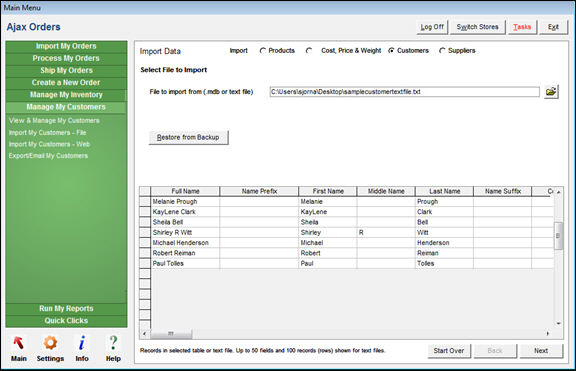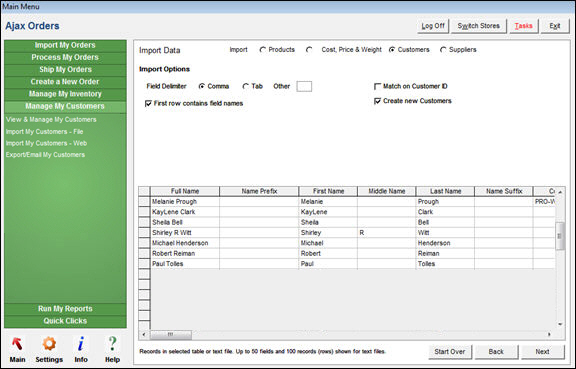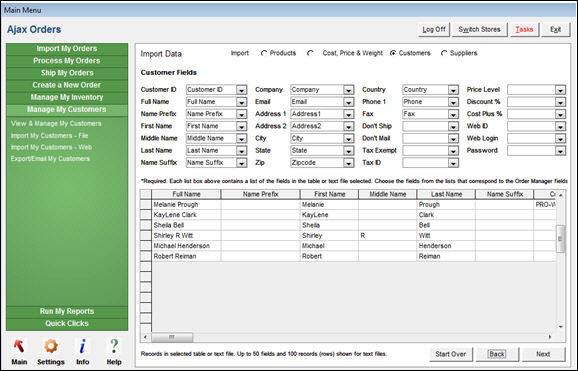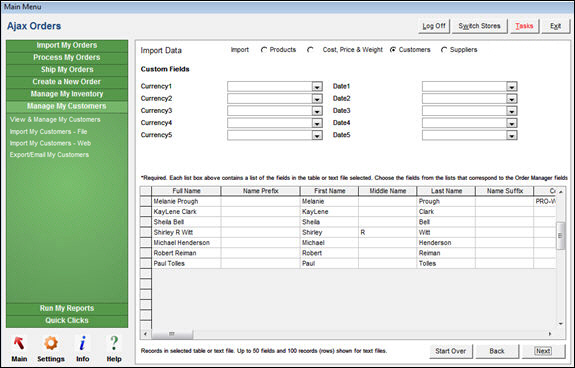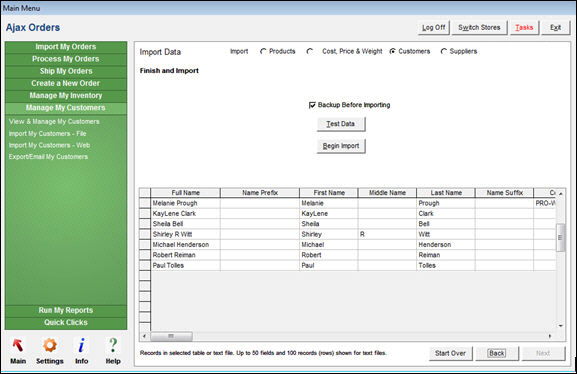Import My Customers
Contents of this Topic: ShowHide
Overview
Several types
of data can be imported through the Import
Data screen, such as Product
(Inventory), Customer, or Supplier
records. Product cost and price information can be imported via this
screen as well.
Data can be
imported from:
A tab or comma-delimited
text file
A table in a Microsoft
Access database
Any other format
(e.g. an Excel spreadsheet or FoxPro table) that can link
to an Access database. For information on linking data in
external tables to Access, please see MS Access documentation.
When importing
data from a text file, if the data contains commas, the file should
be saved as a tab-delimited file, not a csv.
Quotes should
not be present in text files, regardless of whether it is a csv or
tab-delimited file, or you will encounter errors.
To access this
screen go to one of the following areas:
Main
Menu > Manage My Inventory > Import My Inventory - File
Main
Menu > Manage My Inventory > Import Cost, Price & Weight
Main
Menu > Manage My Inventory > Import My Suppliers
Main
Menu > Manage My Customers > Import My Customers - File
The user is
lead through the steps to import the various types of data by a series
of screens.
Depending on
the type of data being imported, fields on the screens change. Refer
to the specific Knowledge Base
topic for the type of data being imported for more details.
This topic
discusses the customer import process.
Description of the Screens
Select File to Import Tab
Import Radio Button
- the Customers
radio button is selected by default
File to import from (.mdb or text file) Field
- enter the path to the file containing the
product information
- the program displays up to 50 fields in the
file and the first 100 records at the bottom of the screen
Folder Button
- select
this button to navigate to the location of the file containing the
product information
Restore from Backup Button
- select this button to restore from a previous
backup, if one was created at the last step of the process
Start Over Button
- returns to the Select
File to Import tab
Next Button
- select this button when ready to proceed to
the Import Options tab
Import Options Tab
Field Delimiter Radio Buttons
Comma Radio Button
- select this button if the fields in the input
file are separated by commas
Tab Radio Button
- select this button if the fields in the input
file are separated by a tab
Other Field
- enter the character used to separate the fields
in the input file
First Row Contains Field Names Check Box
- select this box if the first row in the input
file contains a header record with field names
Match on Customer ID Check Box
- in order to update customer records during
text file import, this field must be selected and system parameter
UseCustomerMatching must be
set to TRUE
- the import text file must also contain valid
data in the fields identified in parameters CustomerSearch1-4,
in order for the program to detect a match
Create new Customers Check Box
- this field is automatically selected and cannot
be changed by the user as it is the default behavior of the feature
- make changes to customer records on import,
see Match on IDdefault behavior of the function when executed without
having customer matching turned on and selecting the Match on Customer
ID check box
Data in Text File or Database Table
- this section of the screen displays up to
fifty fields and the first one hundred records of data in the input
file
Start Over Button
- returns to the Select
File to Import tab
Back Button
- returns to the previous tab
Next Button
- select this button when ready to proceed to
the Customer Fields tab
Customer Fields Tab
- map the fields in the input file to their
counterparts in SEOM:
| Customer ID |
Company |
Country |
Price Level |
| Full Name |
Email |
Phone 1 |
Discount % |
| Name Prefix |
Address 1 |
Fax |
Cost Plus % |
| First Name |
Address 2 |
Don't Ship |
Web ID |
| Middle Name |
City |
Don't Mail |
Web Login |
| Last Name |
State |
Tax Exempt |
Password |
| Name Suffix |
Zip |
Tax ID |
|
Data in Text File or Database Table
- this section of the screen displays up to
fifty fields and the first one hundred records of data in the input
file
Start Over Button
- returns to the Select
File to Import tab
Back Button
- returns to the previous tab
Next Button
- select this button when ready to proceed to
the first page of the Custom Fields
tab, if custom customer fields are defined in the program
Custom Fields Tab - Page 1
- map fields in the input file to any custom
customer Text and Integer fields defined in SEOM
- this tab is not visible is custom customer
fields are not defined
Data in Text File or Database Table
- this section of the screen displays up to
fifty fields and the first one hundred records of data in the input
file
Start Over Button
- returns to the Select
File to Import tab
Back Button
- returns to the previous tab
Next Button
- select this button when ready to proceed to
the second page of the Custom Fields
tab, if custom customer fields are defined
Custom Fields Tab - Page 2
- map fields in the input file to any custom
customer Currency and Date fields defined in SEOM
- this tab is not visible is custom customer
fields are not defined
Data in Text File or Database Table
- this section of the screen displays up to
fifty fields and the first one hundred records of data in the input
file
Start Over Button
- returns to the Select
File to Import tab
Back Button
- returns to the previous tab
Next Button
- select this button when ready to proceed to
the Finish and Import tab
Finish and Import Tab
Backup Before Importing Check Box
- select this box to make a backup copy of the
affected tables before the import is started
Test Data Button
- select this button to have the program check
for errors before starting the import process
Begin Import Button
- select this button to start the import process
Start Over Button
- returns to the Select
File to Import tab
Back Button
- returns to the previous tab
Additional Information
Created:
6/15/12
Revised:
5/18/2015
Published:
04/13/16


